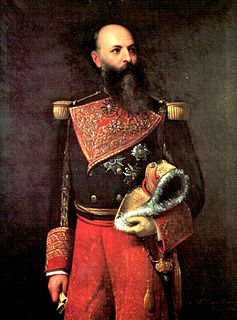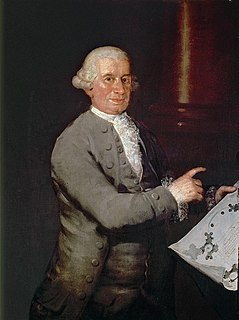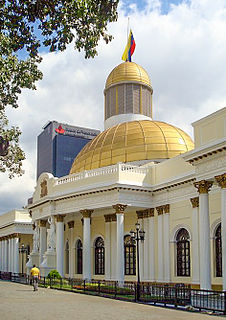
Caracas, officially Santiago de León de Caracas, abbreviated as CCS, is the capital and largest city of Venezuela, and the center of the Metropolitan Region of Caracas. Caracas is located along the Guaire River in the northern part of the country, within the Caracas Valley of the Venezuelan coastal mountain range. The valley is close to the Caribbean Sea, separated from the coast by a steep 2,200-metre-high (7,200 ft) mountain range, Cerro El Ávila; to the south there are more hills and mountains. The Metropolitan Region of Caracas has an estimated population of almost 5 million inhabitants.

Antonio José Ramón de La Trinidad y María Guzmán Blanco was a Venezuelan military leader, statesman, diplomat and politician. He was President of Venezuela for three separate terms, from 1870 until 1877, from 1879 until 1884, and from 1886 until 1887 And General during the Venezuelan Federal War.

Maturín is a city in Venezuela, the capital of the Venezuelan state of Monagas and a centre for instrumental exploration and development of the petroleum industry in Venezuela. The metropolitan area of Maturín has a population of 401,384 inhabitants. Maturín is also a busy regional transportation hub, connecting routes from the northeastern coast to the Orinoco Delta and the Gran Sabana.

Arcos de la Frontera is a town and municipality in the Sierra de Cádiz comarca, province of Cádiz, in Andalusia, Spain. It is located on the northern, western and southern banks of the Guadalete river, which flows around three sides of the city under towering vertical cliffs, to Jerez and on to the Bay of Cádiz. The town commands a fine vista atop a sandstone ridge, from which the peak of San Cristóbal and the Guadalete Valley can be seen. The town gained its name by being the frontier of Spain's 13th-century battle with the Moors.

Martín Tovar y Tovar was a Venezuelan painter, best known for his portraits and historical scenes.

The Central University of Venezuela is a public university of Venezuela located in Caracas. It is widely held to be the highest ranking institution in the country, and it also ranks 18th in Latin America. Founded in 1721, it is the oldest university in Venezuela and one of the oldest in the Western Hemisphere.

Plateresque, meaning "in the manner of a silversmith", was an artistic movement, especially architectural, developed in Spain and its territories, which appeared between the late Gothic and early Renaissance in the late 15th century, and spread over the next two centuries. It is a modification of Gothic spatial concepts and an eclectic blend of Mudéjar, Flamboyant Gothic and Lombard decorative components, as well as Renaissance elements of Tuscan origin.

Ventura Rodríguez Tizón was a Spanish architect and artist. Born at Ciempozuelos, Rodríguez was the son of a bricklayer. In 1727, he collaborated with his father in the work at the Royal Palace of Aranjuez.

The Caracas Cathedral or Metropolitan Cathedral of Saint Anne is the seat of the Roman Catholic Metropolitan archdiocese of Caracas, located on the Plaza Bolívar in Caracas, Venezuela. Its chapel of the Holy Trinity is the burial site of the parents and wife of Simón Bolívar. The Nuestra Senora de Venezuela y Santa Ana is a square (cuadra) situated between the cathedral and the central plaza, which is walled on three sides, but open to the east where it faces the cathedral.

Iglesia de San Francisco is a church in Caracas, Venezuela. Dedicated to Francis of Assisi, it was built in 1593 under the design of Antonio Ruiz Ullán as an annex of the Convent of San Francisco. The church is notable as being the situ where Simón Bolívar received the title "El Libertador" (1813). His funeral occurred here in 1842.

Casco Viejo, also known as Casco Antiguo or San Felipe, is the historic district of Panama City. Completed and settled in 1673, it was built following the near-total destruction of the original Panamá city, Panamá Viejo in 1671, when the latter was attacked by pirates. It was designated a World Heritage Site in 1997.

Edgar C. Otálvora is a Venezuelan intellectual, journalist, and politician who has held government and diplomatic positions. He is an expert in international politics and economics, and has distinguished himself as an analyst of Latin American topics, with a focus on military, diplomatic, and political issues. He has been a columnist in Venezuelans and Americans newspapers, in addition to directing the newspaper El Nuevo Pais in Caracas from 2006 to 2010. He is a professor at the Central University of Venezuela. He was a close collaborator of former Venezuelan president Ramón J. Velásquez. He has cultivated the biographical genre, being the first to write biographies of the 19th century Venezuelan presidents Raimundo Andueza Palacio and Juan Pablo Rojas Paul, as well as the Colombian president Virgilio Barco Vargas. Columnist in Diario Las Américas of Miami.

The Birthplace of Simón Bolívar is a seventeenth-century house in the Venezuelan capital city Caracas where the hero of Venezuelan and Latin American independence, Simón Bolívar, was born. Now a significant tourist attraction, the building is located in a little street off the Plaza San Jacinto, a block east of the Plaza Bolívar. It is one of only a few houses from the colonial era which survive in central Caracas.

The Palacio Municipal de Caracas, or Consejo Municipal de Caracas, is the city hall of Caracas, Venezuela. It is located on the corner of Gradillas a Monjas opposite the Plaza Bolívar, occupying half of the plaza's southern section. The building dates from the seventeenth century but now bears the mark of Alejandro Chataing's Neoclassical additions in 1906. It was the focal point for the Constitutional Convention, and signing of the Declaration of Independence in the nineteenth century. The present building is the result of the work undertaken by the Venezuelan architect Alejandro Chataing in 1906. The west wing of the building, the Capilla de Santa Rosa de Lima, the chapel where Venezuela's independence was declared in 1811, has been fully restored and furnished with authentic period pieces. The ground floor houses the Museo Caracas, which contains works by Venezuela's most celebrated painters and many other historic artifacts. It was declared a National Historic Landmark on 16 February 1979.

The Palacio Federal Legislativo, also known as the Capitolio, is a historic building in Caracas, Venezuela which houses both the National Assembly and the National Constituent Assembly. Located southeast of the Plaza Bolívar, it was built between 1872-1877 by President Antonio Guzmán Blanco to a design by the architect Luciano Urdaneta Vargas. The Salón Elíptico, opened in 1877, is topped by a golden dome.

The Convento del Carmen Calzado was a convent in the Order of Mount Carmel. It was located in the area currently occupied by the Plaza del Carmen in Madrid. This convent was founded in 1573. The Spanish confiscation during late-19th century left only the Parish church del Carmen and the ensanche (widening) of the area of Plaza del Carmen. One of the ten streets leading to the Puerta del Sol, and passing next to the facade of the parish church, is called Calle del Carmen. The site of the convent was dedicated to the Frontón Central, which would become the Cine Madrid.

The now defunct Convento de San Felipe el Real was a former Madrilenian convent of Calced Augustinian monks, located at the beginning of Calle Mayor in Madrid, next to the Puerta del Sol. Built between 16th and 17th centuries, was rise on a large pedestal, was part of it a famous talking shop of the city. One of its famous guests was Friar Luis de León. It was opposite the Palacio de Oñate.
The Convento de la Natividad y San José was a convent of Carmelite nuns located in Calle de Alcalá (Madrid). Was designed and started to build the building by foreman Juan de Lobera in mid-17th century, being finished in 1700 by his son-in-law Juan de Pineda. The convent due to the Confiscation of Mendizábal was demolished in 1836 and its site put on sale.
The 2018 Primera División season, officially Liga de Fútbol Profesional Venezolano or Liga FUTVE, was the 37th professional season of Venezuela's top-flight football league. Monagas were the defending champions, but did not qualify to the Serie Final, after being eliminated in the regular season of the Torneo Apertura and by Caracas in the quarter-finals of the Torneo Clausura.





















